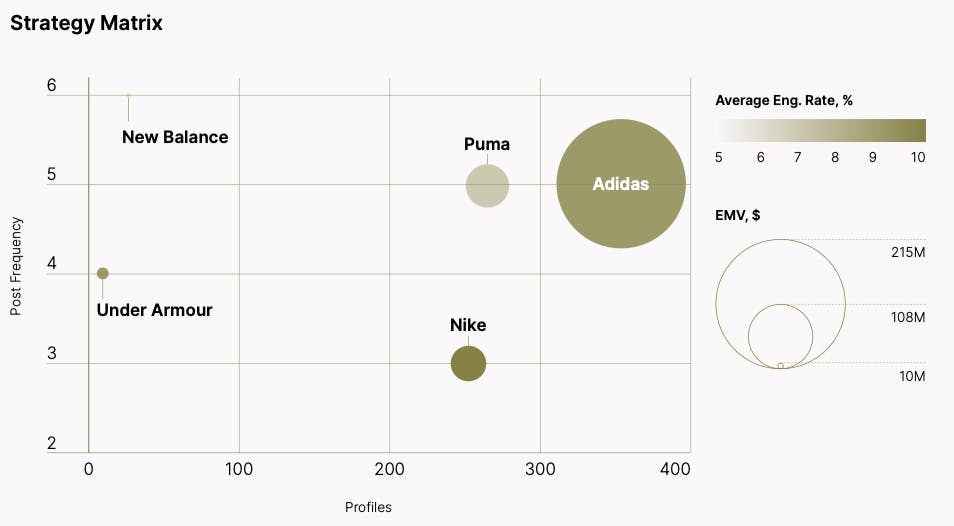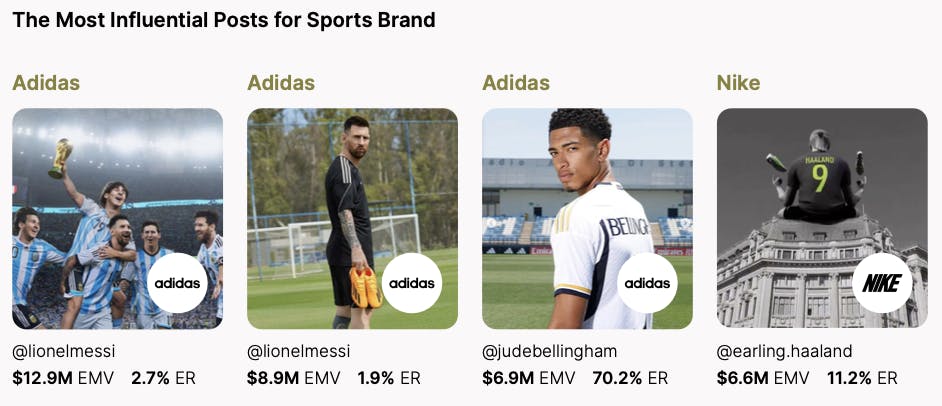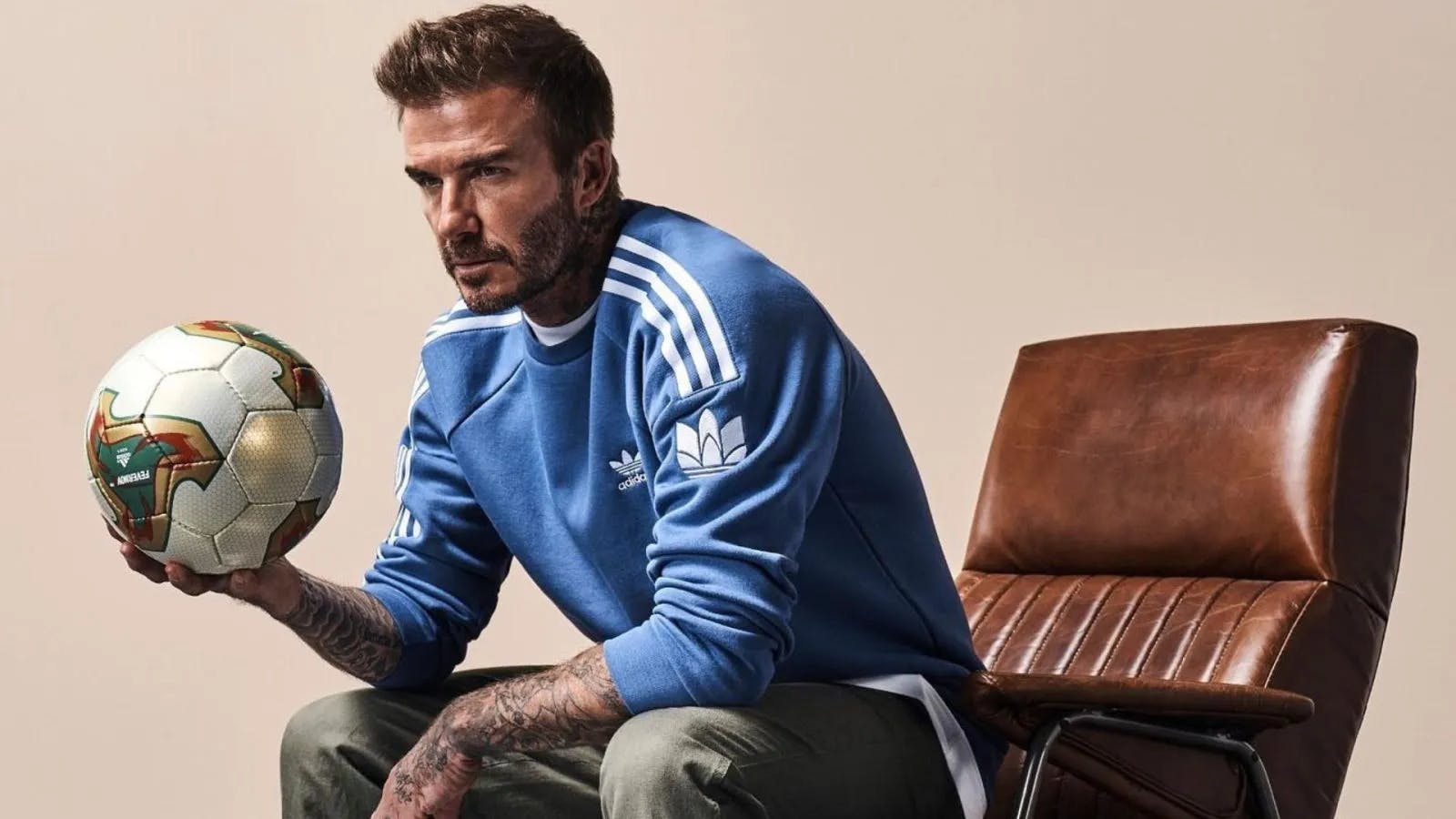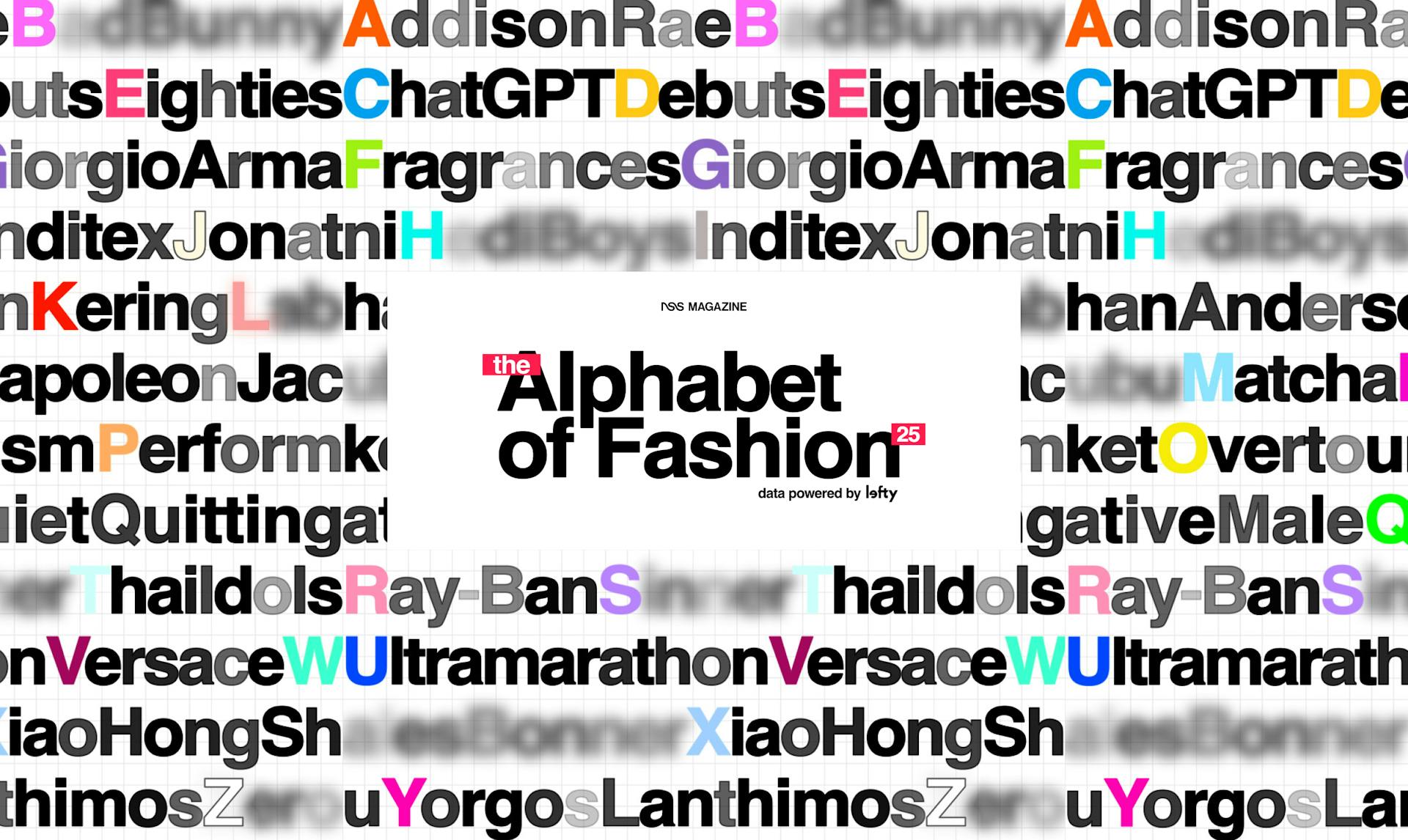Contents:
- The Influence of Sport
- The Impact of Sports on Instagram
- Market Distribution
- Football Fever
- F1 Accelerates Impact
- Sports & Style: A Clear Win
- The Sport of Influence
- Women Rising
- Scoring with Beauty and Wellness
- Rooting for the Underdog
- Action Points
- Data Appendix
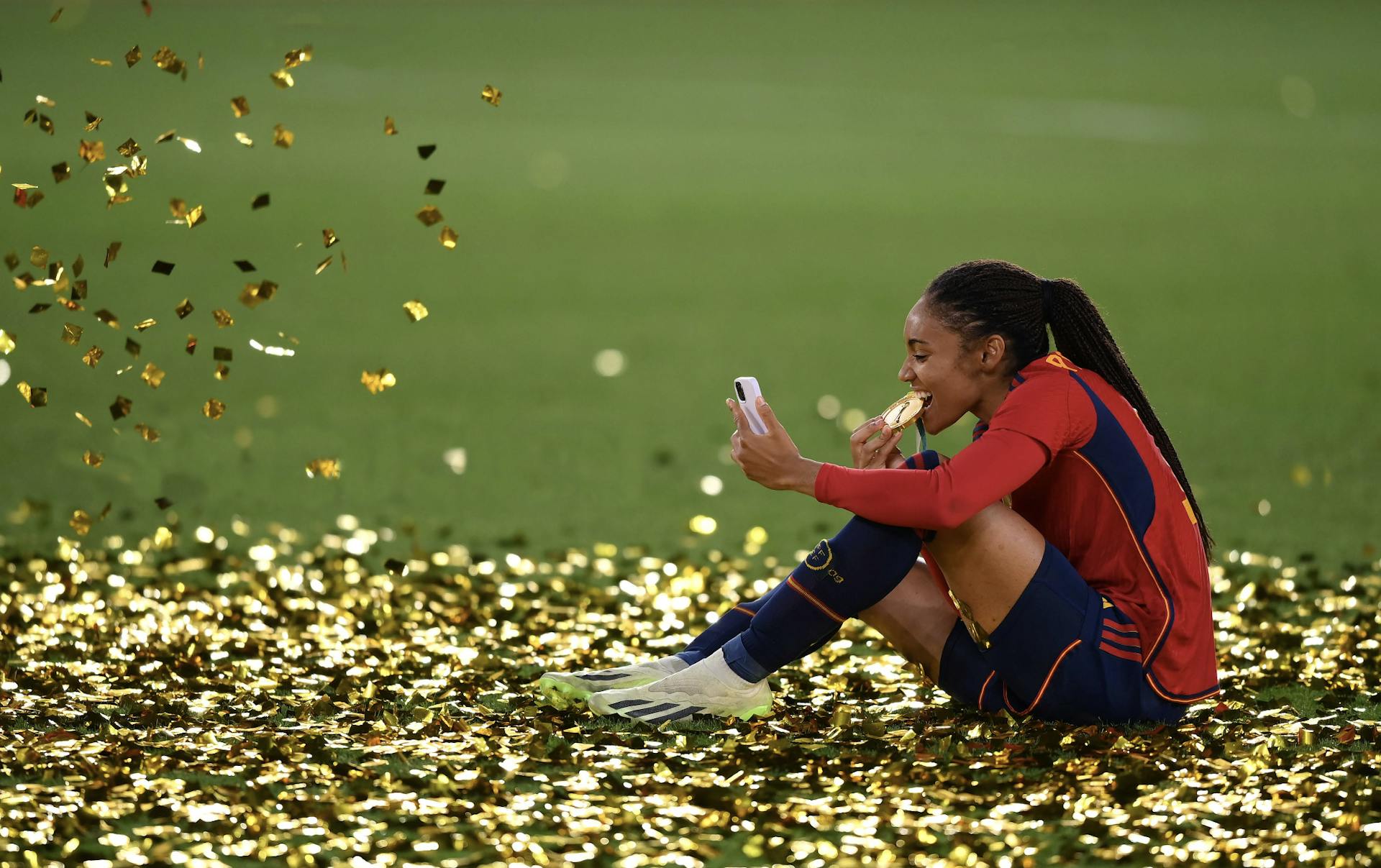
Introduction
Sports Impact Soars by 35% YoY
Sport is undeniably at the height of the cultural zeitgeist. This summer's events, from Wimbledon to the Women's World Cup, have shattered viewership records, consequently boosting Sports EMV (Earned Media Value) by an average of 35% YoY, according to Lefty data.
LVMH Goes for Gold
However, ticket sales and broadcast figures are now only a drop in the ocean. Social media has catapulted sports' impact and made the eyes on them wider than ever. Consequently, partnerships are flourishing as brands compete for a slice of sports' expansive influence and meet consumers where they spend time. This is illuminated by luxury super-conglomerate LVMH's significant partnerships deals in the upcoming 2024 Olympics and Paralympic Games, spanning everything from fashion to hospitality.
Meanwhile, athletes and sports clubs are forging deeper links with the creative sphere, gracing high-profile events, such as Men's Fashion Month, or appointing Creative Directors to build innovative, creative strategies, such as influencer partnerships and merchandise opportunities.
Athletes are the Ultimate Influencer
But what makes athletes such successful influencers? Authenticity reigns supreme. Their endorsement of products is often linked to their performance, lending everything they touch unmatched validity. Additionally, sports have community front and center, often with religious-like followings, making their athletes some of the most engaged icons worldwide.
Sport in the Age of Social Media
Social media has only perpetuated sports' influence, meanwhile introducing a fresh wave of diverse, socially savvy, brand-conscious athletes to its platforms. This surge brings with it a new wave of cultural relevance and untapped partnership prospects.
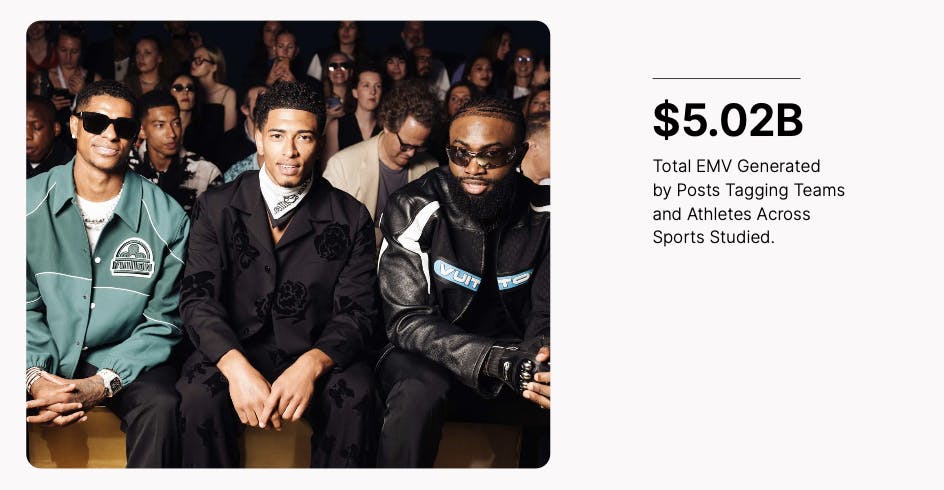
Sports By Numbers
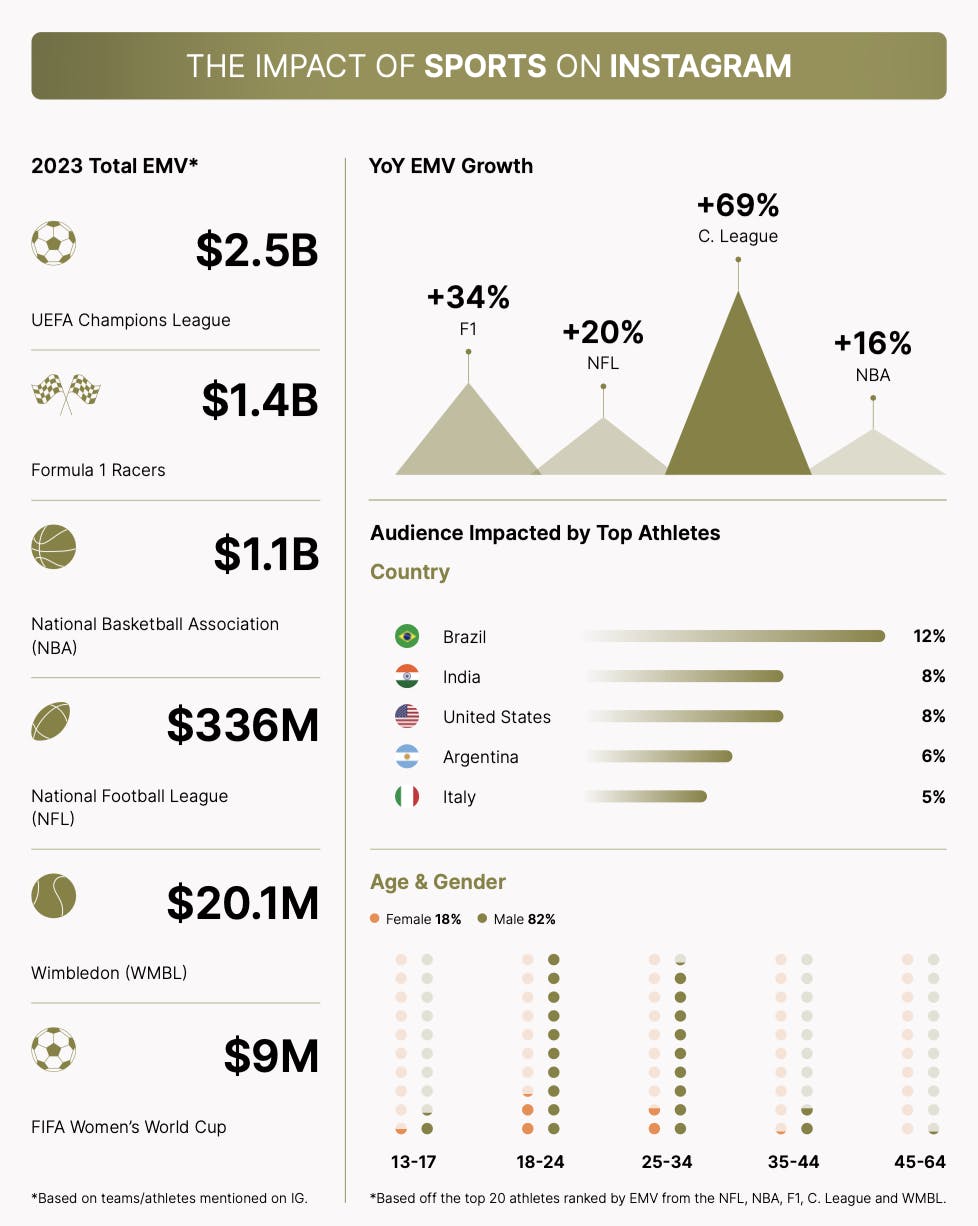
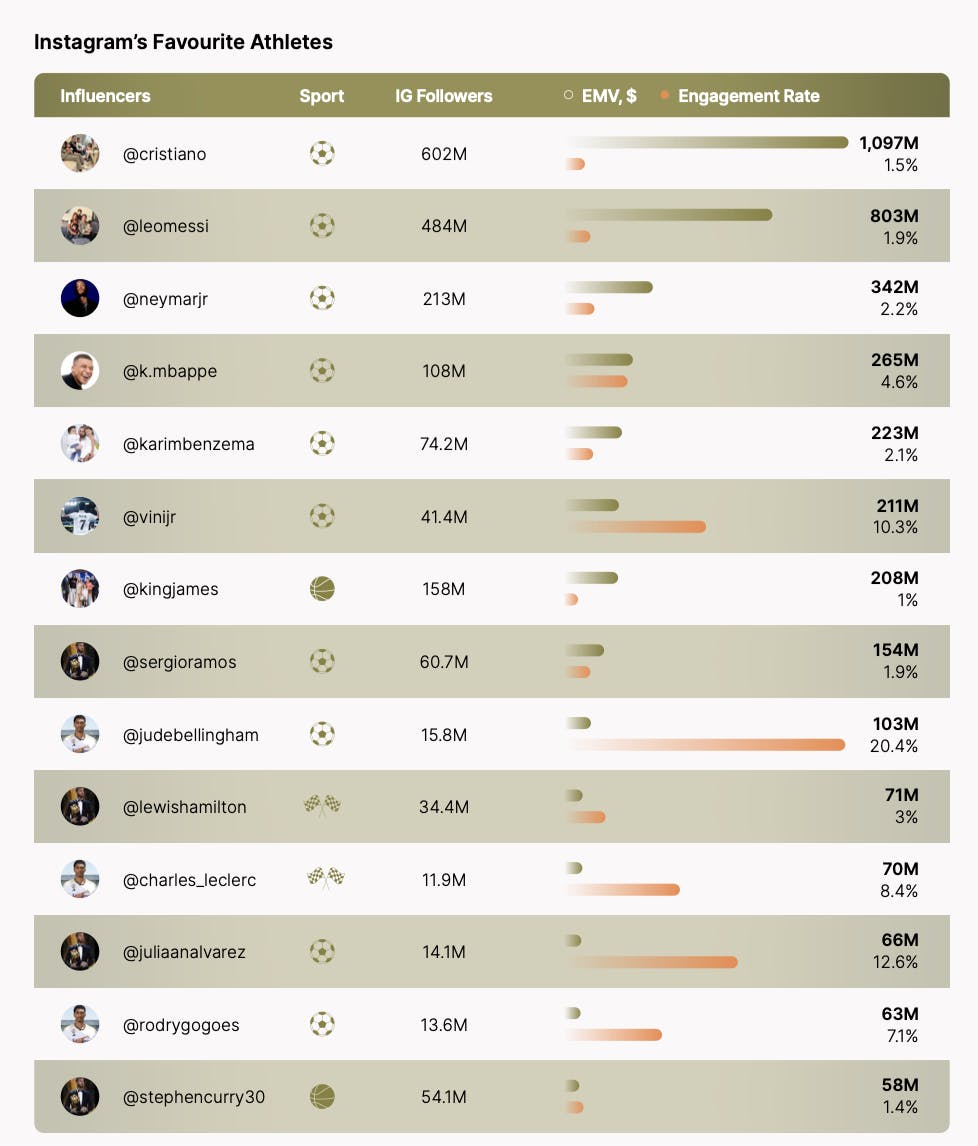
Market Distribution: Brand x Athlete Partnerships
In 2023, athletes collaborated with over 15 different industries, with sports and fashion leading the way, accounting for 78.3% of the total share of voice in EMV.
Leading Verticals
- Sports: $486M EMV
Sports brands have a natural lead in the market, amassing $485 million in Earned Media Value (EMV), representing 68.9% of the total EMV. This is underscored by their leading counts in posts (5.9K) and profiles (1.1K), alongside an impressive average EMV per brand of $11 million.
- Fashion: $78.5M EMV
Fashion houses are advancing in the sports market, accumulating a remarkable $78.5 million in Earned Media Value (EMV). 63 fashion brands engaged in collaborations with athletes in this study.
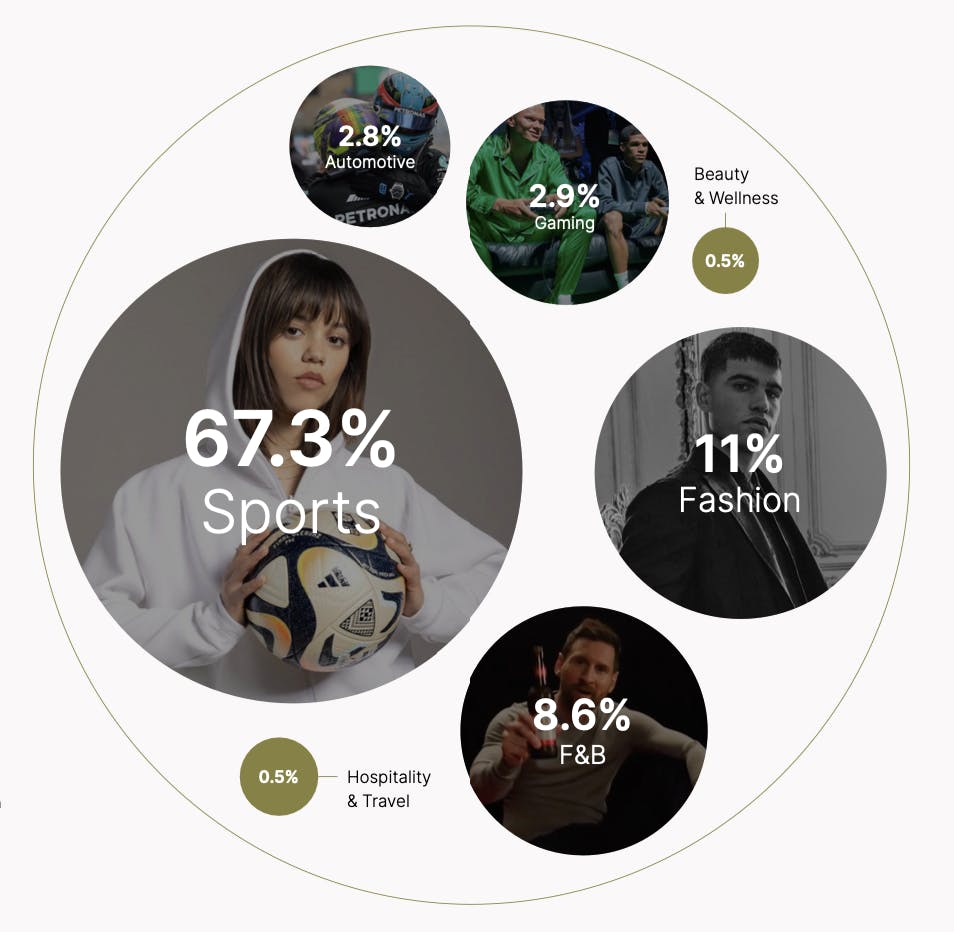
Emerging Verticals
- Food & Beverage: $61.9M EMV
Half-time broadcast placements from F&B giants such as Budweiser, Pizza Hut, etc., dominate partnerships here.
- Gaming: $21M EMV
Gaming and sports are intrinsically linked, as evidenced by the average EMV value of gaming powerhouses collaborating with athletes, generating $9.7 million.
- Automotive: $20.4M
F1's growing impact on culture drives its automotive players into the spotlight, while influencer partnerships in car rental create opportunities.
- Beauty & Wellness: $3.6M EMV
With the impact of Women's sports rising and contemporary gender norms being redefined by a new generation, the beauty industry has tremendous growth potential.
- Hospitality & Travel: $3.8M EMV
Athletes have to get from A to B somehow, thus partnerships with airlines, hotels and hospitality providers are growing partnership opportunities. VistaJet and the Scuderia Ferrari team are key examples. Carlos Sainz and Charles Leclerc have generated an impressive $1.7 million in EMV for the airline.
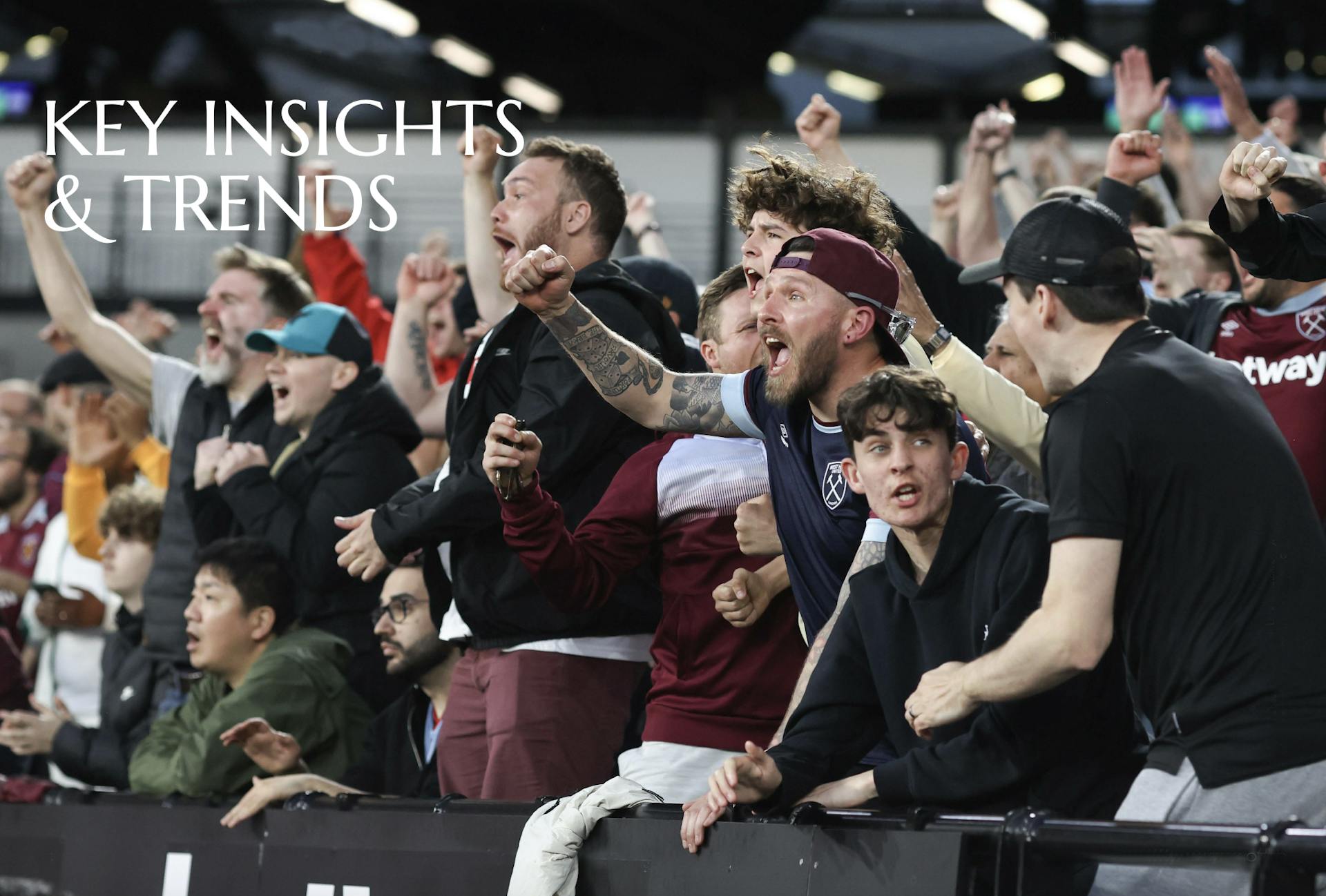
Football Fever
The Most Powerful Sport in the World
Association Football, commonly known as Football or Soccer, is the world's most powerful sport, boasting an astounding 3.5 billion fans globally (Sportsmonkie, 2023). It's not just an unmatched fan base; it's the colossal reach in broadcasting rights, sponsorship deals, and media value. The 2023 UEFA Champions League alone raked in $2.47 billion in Earned Media Value (EMV), marking a remarkable 69% year-over-year growth, as per Lefty data.
A Sponsorship Playground
With a sizeable and diverse fan following (which is ever diversifying, thanks to TikTok trends such as #blokecore), football finds itself in the height of the cultural zeitgeist and the enviable position of choice when it comes to brand partnerships. Particularly in European leagues, teams and players are awash with official sponsors, spanning everything from sports brands to banking, food, beverages, entertainment, travel, and hospitality.
Beyond the Jerseys
Football's appeal has transcended traditional sponsorship opportunities in recent years, attracting new brands from across the creative sector. According to Lefty data, fashion endorsements now constitute 14.6% of the marketing mix, second only to sportswear brands. The partnership landscape for luxury has evolved dramatically, spanning VIP dressing to a full-blown club or athlete-specific merchandise collaborations.
This transformation is largely attributed to the sport's increasing commercialization and redefinition of its players' image, making for a more attractive partnership space for luxury giants. Even leaders in 'quiet luxury,' such as Loro Piana and Zegna, are now outfitting teams like Juventus and Real Madrid, while Moncler and Inter Milan have ventured into fully-fledged capsule collections.
A Win-Win Scenario
Traditionally, team merchandise has been a reliable revenue stream for clubs. However, many leading clubs are now enlisting Creative Directors to harness the potential of creative collaborations, fashion collections, and partnerships, breathing new life into traditional partnership models and transforming them into full-fledged revenue brands.

Footballers are Winning Influencers
Much of football’s growth can be attributed to its players, who have evolved into global celebrities. They account for a staggering 68% of the athletes generating the highest EMV, underscoring their dominance. Football’s PR teams have ensured players' images and partnerships are holistic as they engage in diverse initiatives, including charity work, environmental initiatives, and brand partnerships that span markets and industries, expanding the sport's—and the players'—reach.
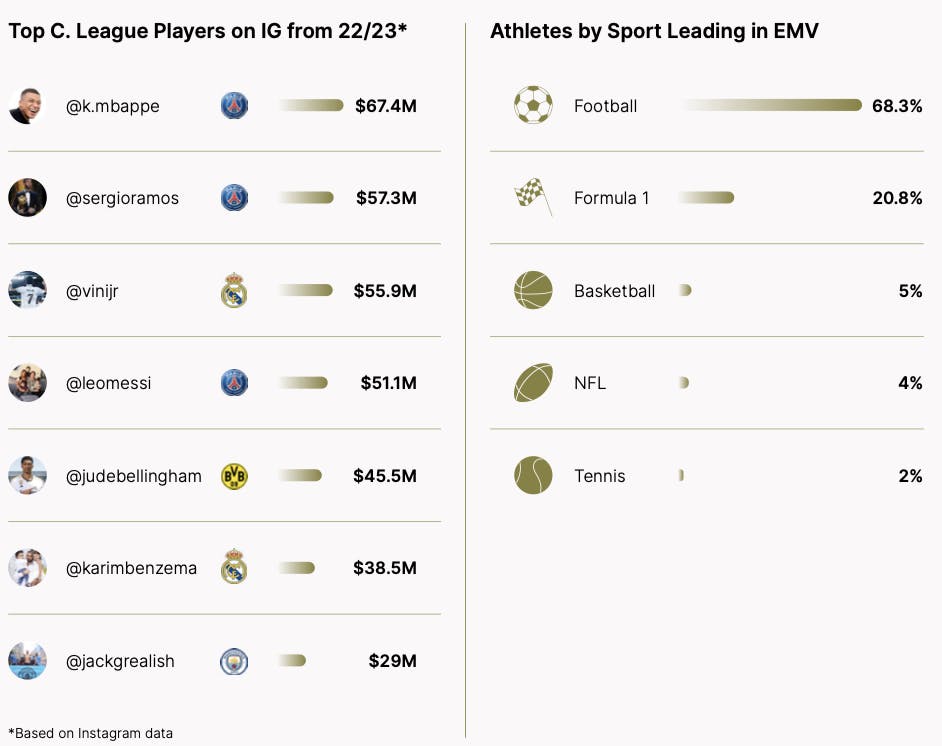
Football Fever Case Study: @hm_son7
Signed to Tottenham Hotspur, Son Heung-min is the most engaged player of 2023’s UEFA Champions League, at 14.81%, and is widely considered one of the best Asian players in history.
Although Son ranks #10 by EMV, his high engagement demonstrates his posts' impact on his audience.
Son Heung-min has sealed a prolific range of brand partnerships, spanning computer gaming, food and beverage, and high fashion, with his partnership with Burberry driving the most significant EMV at over $4 million USD.
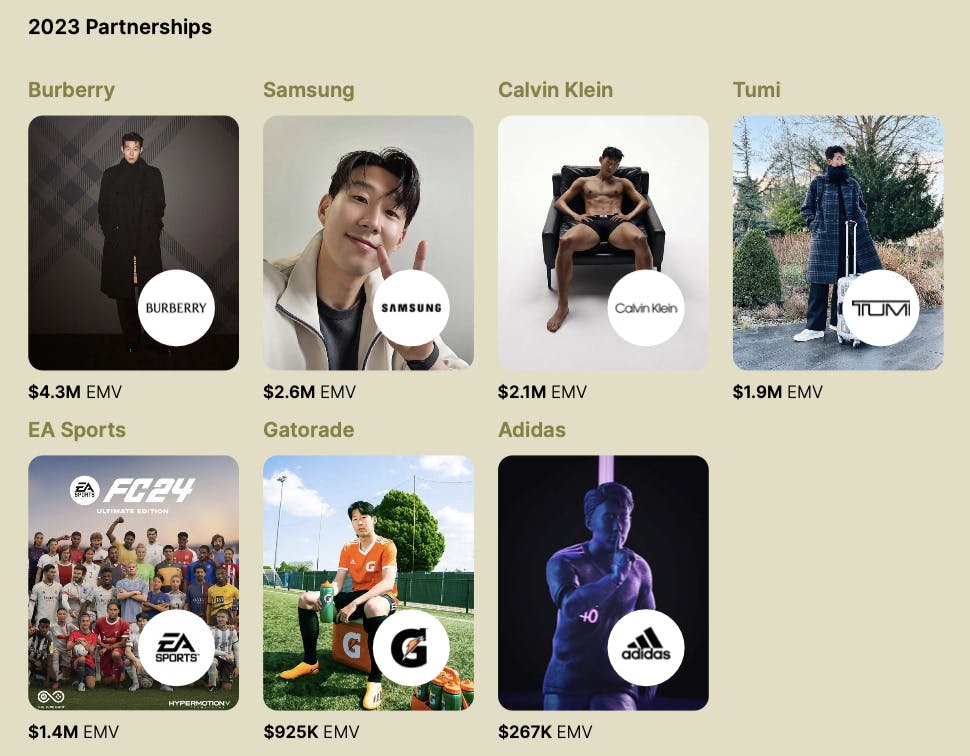
Audience Impact
Korean footballer Son Heung-min experiences significant engagement from a passionate local fan base, similar to popular K-pop idols. This is bolstered by South Korea's vibrant fan culture and large population of social media users.
28% of Son Hueng-min’s Instagram audience are South Korean, while only 4% are British.

F1 Accelerates Impact
Formula 1 emerges as the second fastest-growing sport in Earned Media Value (EMV), surging +34% in 2023 compared to the same period in 2022, as per Lefty data. F1 drivers excel in engagement, boasting a top-tier 6.2% ER average.
Once confined to a predominantly European audience, much of the sports’ growth can be pinned to its media strategy transformation, overseen by Liberty Media Corporation, who acquired F1 in 2017. By fostering cross-seas broadcasting partnerships with ESPN and Sky, F1 expanded global relevance, including a notable +28% US viewership to 1.21 million on ESPN in 2022.
A Cultural Drive
Netflix's 'Drive to Survive' docuseries has elevated F1's cultural appeal, showcasing unprecedented access to the drivers and sport. As per YouGov Sports, the show captivated 6.8 million viewers, particularly 18-29-year-olds (31%) and females (49%), showcasing a shifting demographic. Expect F1's cultural prominence to grow with the upcoming Apple Original Film 'Apex,' in partnership with top-ranked driver Lewis Hamilton.
Meanwhile, F1 has evolved its social media strategy, lifting the ban on footage captured within the paddock, fostering a heightened athlete-audience connection, and expanding marketing reach across platforms.
F1's Fashion Joyride
F1's growth has prompted an avalanche of investments in cross-sector sponsorships, partnerships, brand activations, and placements, including car livery sponsorship, after-parties, on-site hospitality, and VIP dressing. Naturally, Automotive companies lead in EMV, generating $19.1M in 2023, while luxury fashion closely follows at $18.8M EMV, holding nearly a quarter of the share of voice.
Lewis Hamilton stands out as a constant value driver for luxury brands. While endorsing Tommy Hilfiger ($4.99M EMV) — the sponsor of the Mercedes Benz team — Hamilton consistently drives media impact for luxury labels as varied as Louis Vuitton to Saul Nash. The driver is now a front-row favorite, even starring in high-profile campaigns such as Valentino, making him F1’s most valuable driver in terms of media impact at ($186.4M EMV).

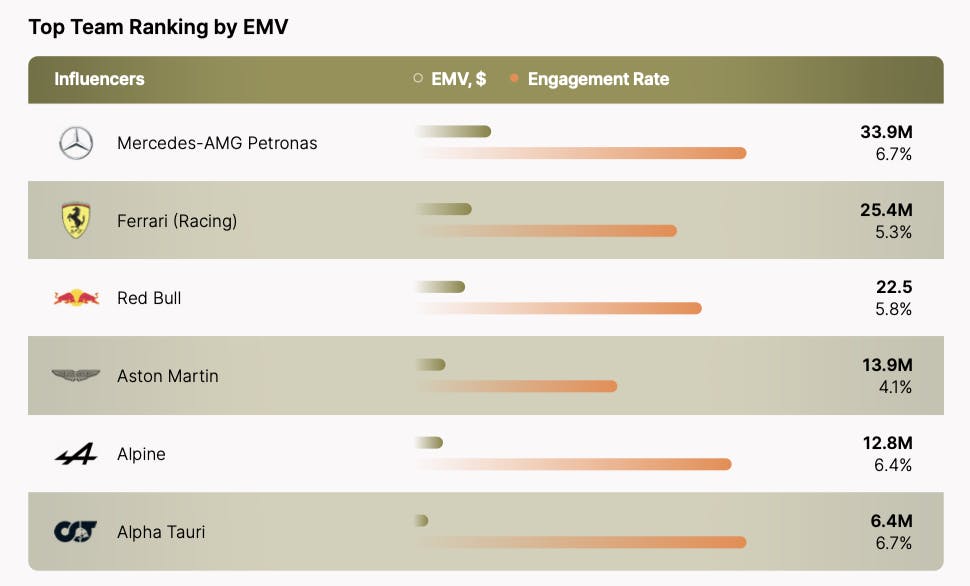
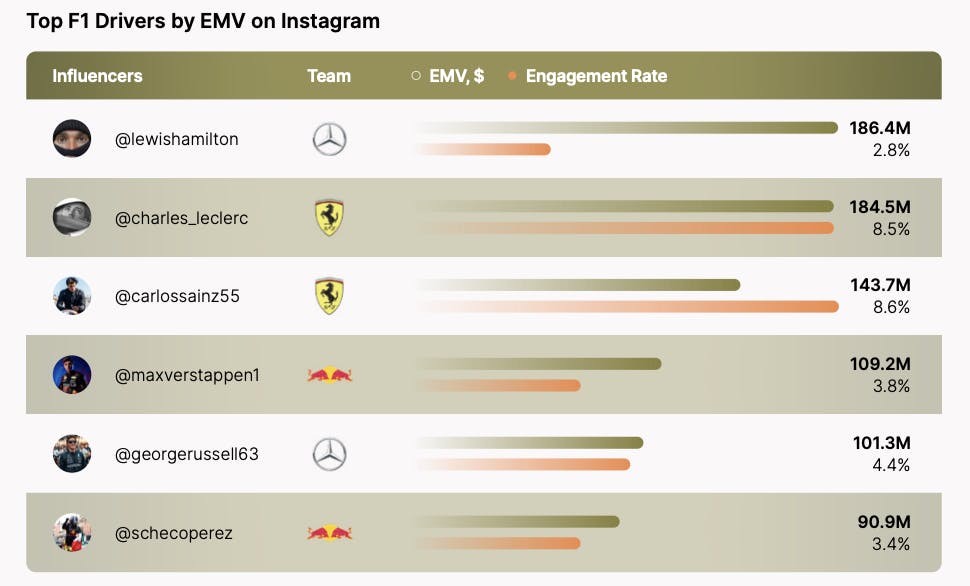
F1 Accelerates Impact Case Study: Louis Vuitton's Race to the Top
Luxury fashion brand Louis Vuitton stands out as a prime beneficiary of Formula One's cultural influence. By sponsoring esteemed events like the Monaco Grand Prix, complete with trophy trunks and VIP boxes, and dressing some of the sport's most notable figures, the brand has amassed an impressive $6 million in Earned Media Value (EMV).
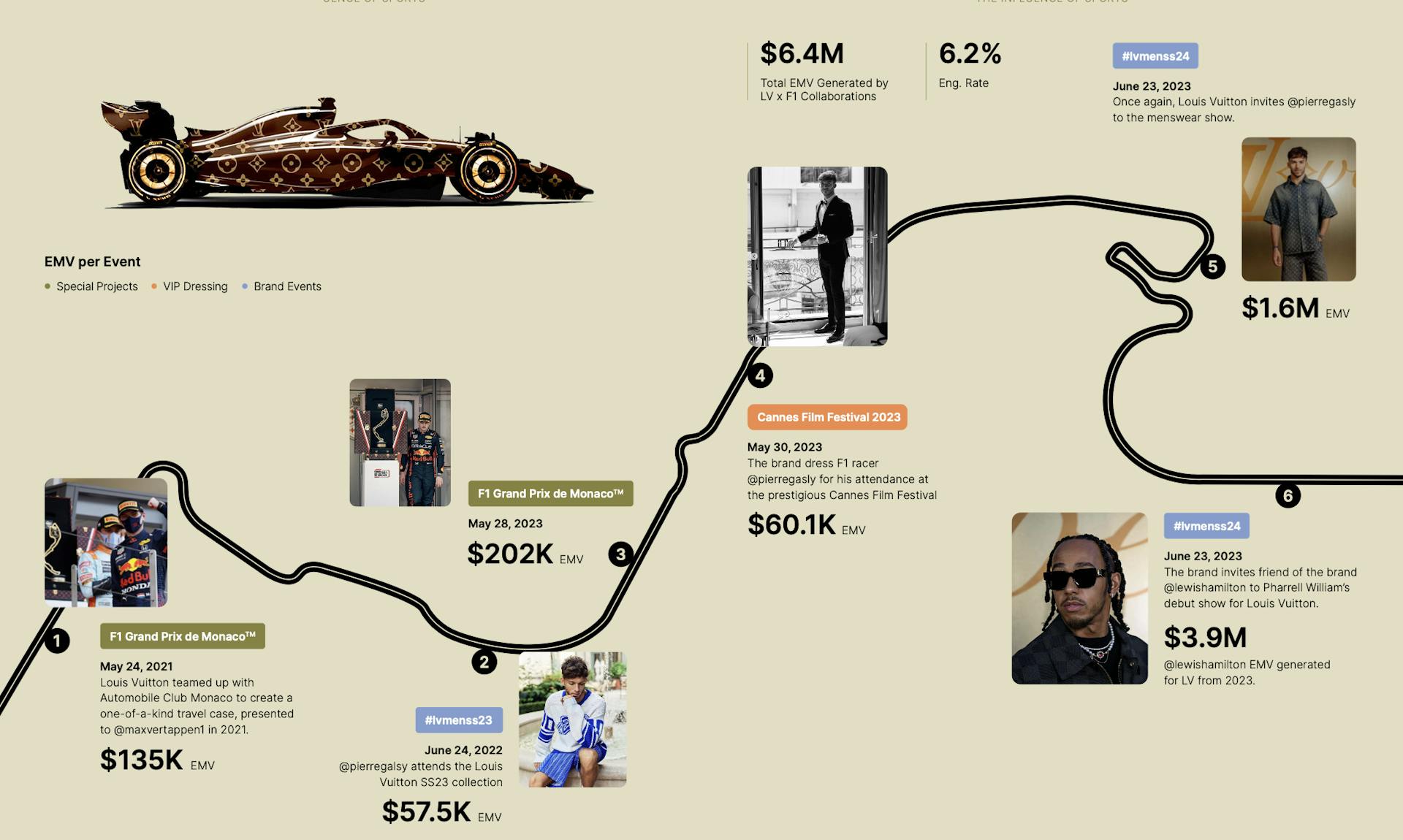
Sports & Style: A Clear Win
Game, Set, Gucci
Italian tennis sensation Jannik Sinner didn't just steal the spotlight at Wimbledon 2023 with his powerful serves; he also made a bold fashion statement by flaunting a monogrammed Gucci bag courtside. This iconic moment challenged Wimbledon's strict dress code and marked a historic entry of luxury luggage onto the court. According to Lefty data, sinner's post generated an impressive $175,000 in Earned Media Value (EMV) for Gucci.
While tennis has long been associated with sports brands and luxury ties, Lefty's data reveals a changing landscape. Fashion brands now claim a larger slice of the Wimbledon pie than their sports counterparts, contributing over half of Wimbledon 2023's EMV at $13.5 million, while sports brands generated $4.4 million.
All Eyes on the NBA and NFL
Beyond traditionally elitist sports such as F1 and tennis, luxury brands are recognizing the mass appeal of style-savvy stars in the NBA and NFL, two of the biggest revenue-generating sports in media after football, as reported by SportsBusiness.
NBA stars, in particular, are rewriting off-court style with their legendary 'Tunnel Fits,' showcasing directional styling from the likes of Rick Owens and Thom Browne. Their impact has caught the eye of major fashion brands: in Men's SS24, athlete rankings surged from #14 in AW23 to #5 in SS24’s show attendees, with Lefty monitoring a remarkable 120 athletes throughout the season – 37% of whom were NBA stars. With his appearance at Louis Vuitton, LeBron James alone generated over $1 million EMV.
BOSS Defines its Athletic Edge
The NFL’s icons boast just as much style credibility, with fashion brands accounting for over 32% of the share of voice by EMV. BOSS continues to define its athletic edge, collaborating with NFL players and tapping into the entire ecosystem of the NFL with a range of merchandise collaborations and athlete partnerships - boosting it to the number #3 most visible brand in the sector. Notably, Netflix’s recently released ‘Quarterback’ series is poised to have the same cultural impact as F1’s ‘Drive to Survive,’ making the sport ripe for partnership explorations.
For brands eyeing the lucrative US market, aligning with stars and clubs across these popular leagues could prove a rewarding opportunity.
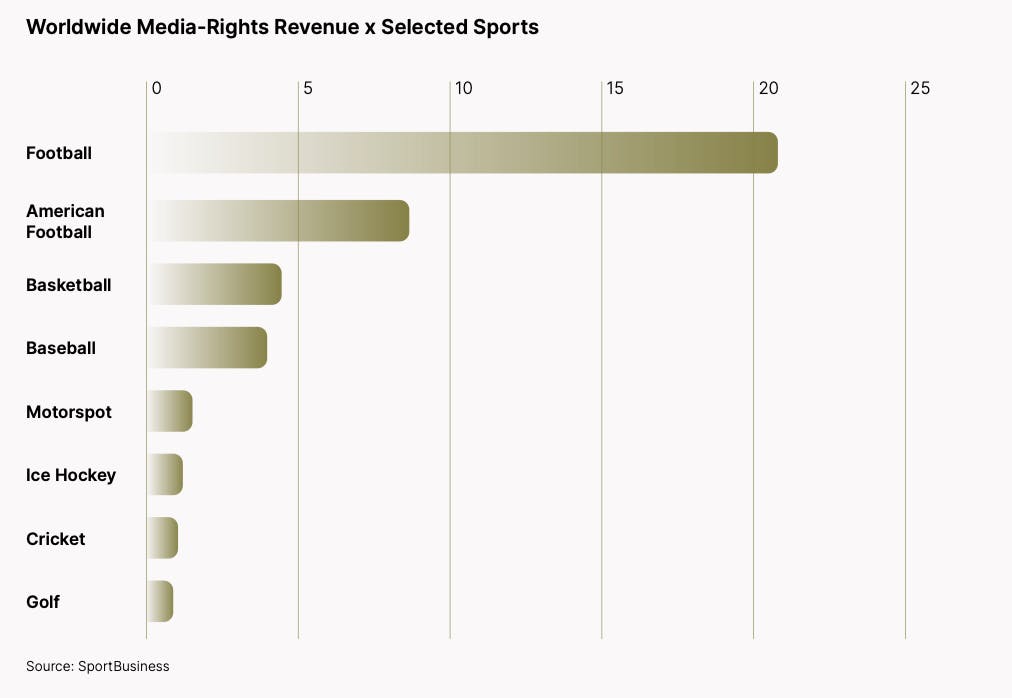
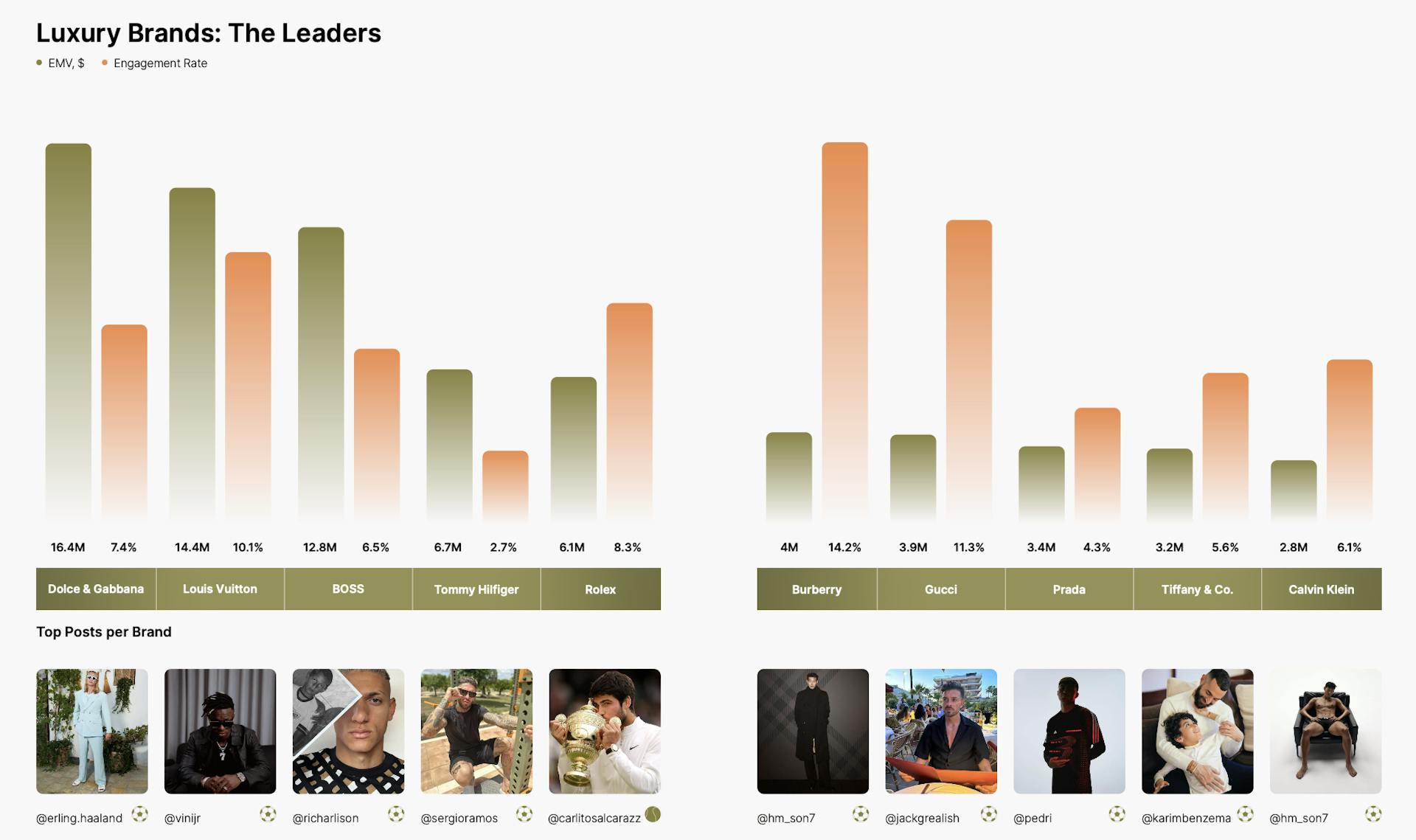
The Sport of Influence
Kicking and Streaming
With much of a game’s value now hinging on viewership and brand visibility, many sports entities and sponsors are investing more heavily in influencer marketing during games in order to drive visibility and meet consumers where they’re spending time – live streaming sports via their mobile devices.
Although celebrity appearances are not a new concept, the impact of social media has reshaped the the culture of celebrity and its impact on sport, meaning that who’s at the game is just as important as who’s in the game.
Gen Z Drive Demand for Celebrity Content
This shift resonates more deeply with younger generations. According to Lefty’s data, Millennials and Gen Z demographics are the most engaged in sports content, which showcases not only how these generations are viewing sport across media platforms, but how they’re engaging with the ecosystem of entertainment within the sport industry.
As a result, sports entities are creating more strategic social media strategies and influencer partnerships, working with popular K-Pop icons to fashion influencers, ultimately broadening the appeal and audience of sports overall.
The Power of The Patner
As athletes achieve global stardom, brands are rethinking the role of partners in connecting with fans. The traditional 'WAG' label (Wives and Girlfriends) is evolving as partners of players (or 'POPs') venture into content deals.
Take Morgan Riddle, girlfriend of US tennis star Taylor Fritz, for instance. In 2023, she partnered with Wimbledon for 'Wimbledon Threads,' a fashion series whereby Riddle interviewed attendees about their outfits. The content aired across Wimbledon's social channels, raking in $359K in EMV.
For brands not naturally tied to a sport, teaming up with a partner offers a lucrative avenue to engage fans and redefine athlete branding.
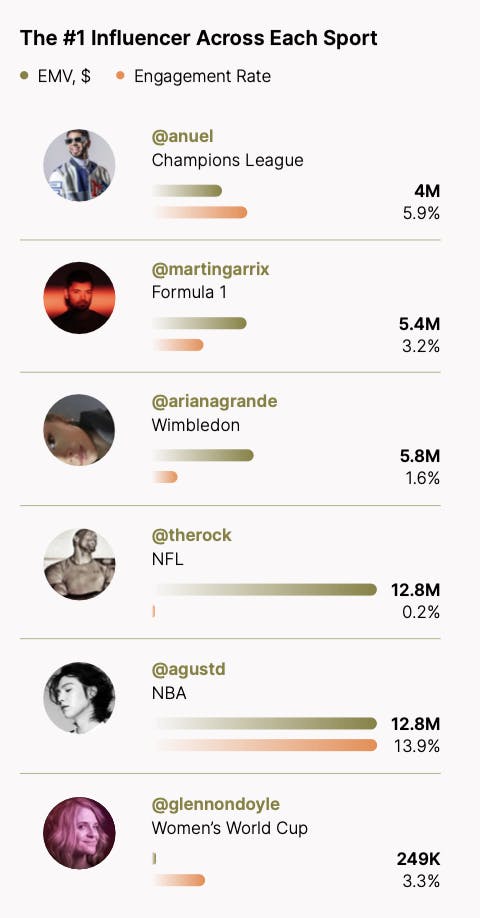
The Sport of Influence Case Study
The NBA Celebrity Strategy
The NBA has historically welcomed celebrities courtside and stands out as a leader in influencer relations. More recently, the association has amplified the diversity of its influencers, working with the likes of K-Pop and Reggaeton stars and enveloping fellow athletes on the basketball equivalent of the FROW. Notably, according to SportsBusiness, in 2022, the NBA will be the third biggest streamed sport globally, meaning that a diverse range of influencer partnerships makes perfect business sense to heighten its global appeal.
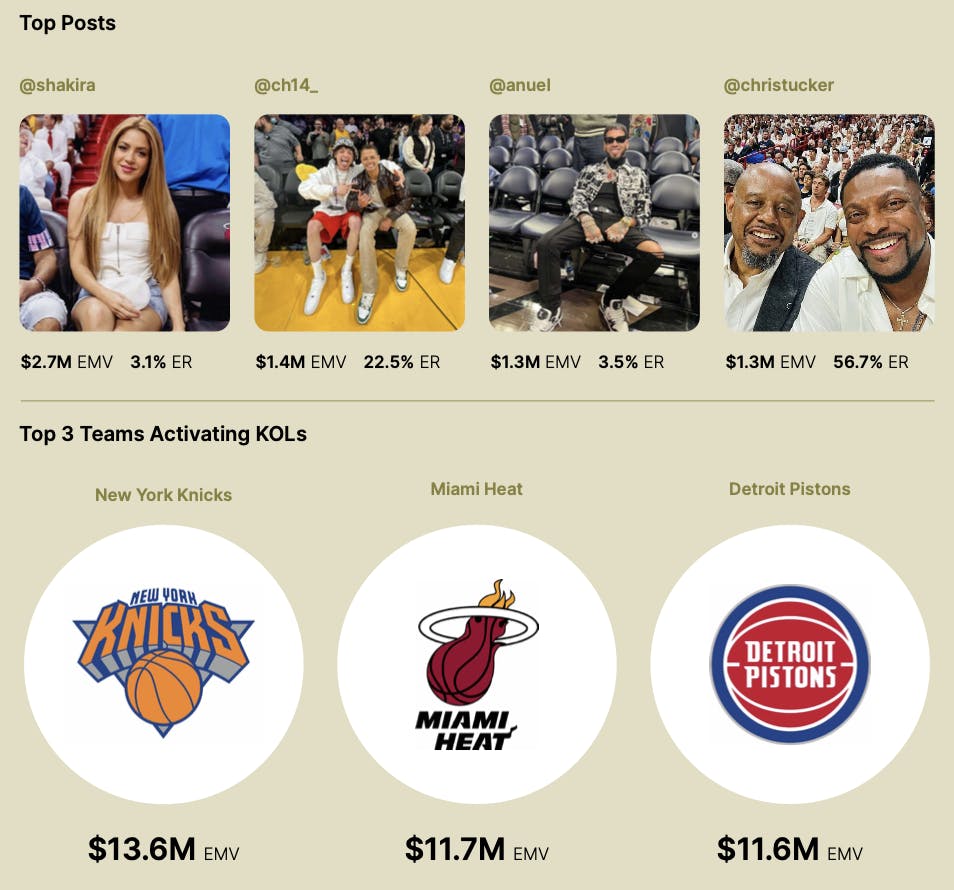
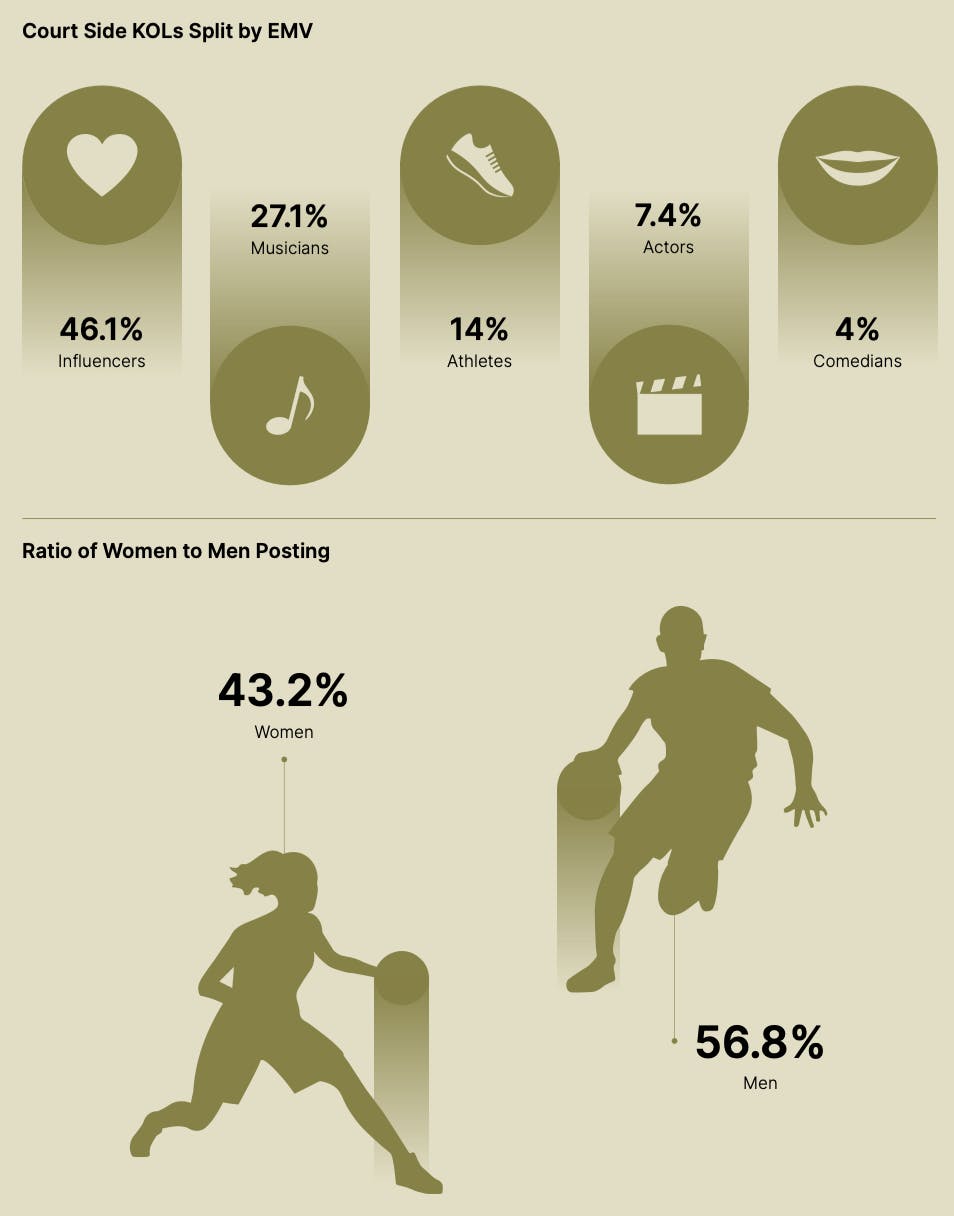
Women Rising
Empowering Shift in Women's Sports
The release of the Barbie Movie alongside the Women’s World Cup in 2023 heralded a fresh wave of female empowerment. Change is in motion in the historically male-dominated sports arena.
FIFA's data presents record-breaking viewership, reaching an estimated 2 billion for the Women’s 2023 final, surpassing 2019's 1.12 billion. Meanwhile, Lefty's data highlights notable audience shifts in comparison to other sports studied. Social media engagement statistics underscore that female audiences make up a substantial 44% of audience data, a sharp contrast to the mere 17% across other categories. Particularly, young women aged 13-17 emerge with a 5% audience rate, outpacing their male counterparts at 2%, showcasing how the event has ignited inspiration among the next generation of young women.
Female Athletes Boast Record Engagement
This change is chiefly propelled by the upsurge in televised women's sports, which has thrust female athletes into the spotlight. Lefty's analysis demonstrates female athletes’ exceptional engagement rates, notably surpassing male counterparts with an impressive 14.3% rate.
Brands Embrace Female Athletic Influence
Industry leaders like Nike are driving transformation. During the prestigious Haute Couture Week, Nike’s ‘Goddess Awakened’ performance united a cohort of Nike athletes in a dance narrative of feminine expression. According to Lefty's data, this event generated over $650K EMV, epitomizing Nike’s significant investment in women's wear and athletes.
As the impact of female athletes grows in tandem with increased viewership of women's sports, opportunities for brand partnerships are expanding in the sector. Several brands swiftly recognized this potential. Martine Rose partnered with Nike, outfitting the USA squad in formalwear, and Prada did the same for China’s team. Emerging designer Grace Wales Bonner crafted Jamaica's team kit for the tournament. However, the opportunities aren’t limited to fashion: Lefty’s data showcases the proliferation of market categories entering partnerships with women – beauty, for one, emerges as an under-explored market opportunity.
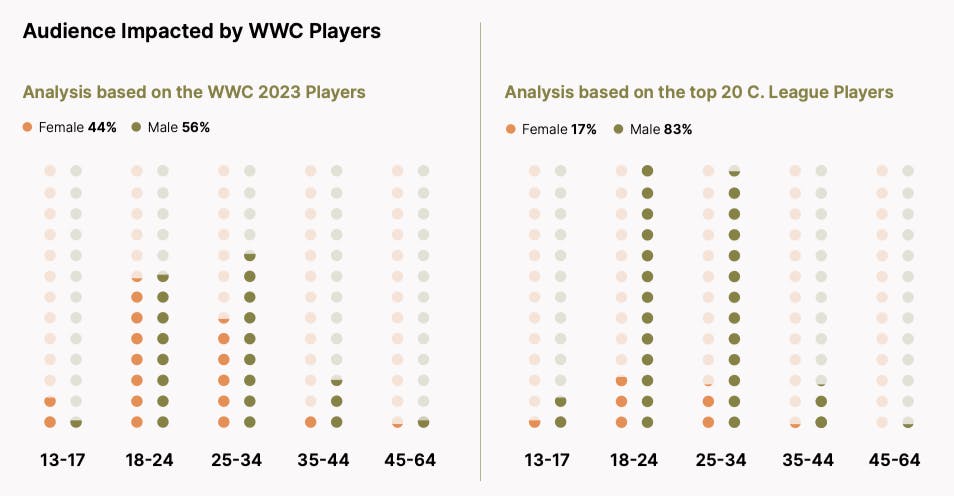
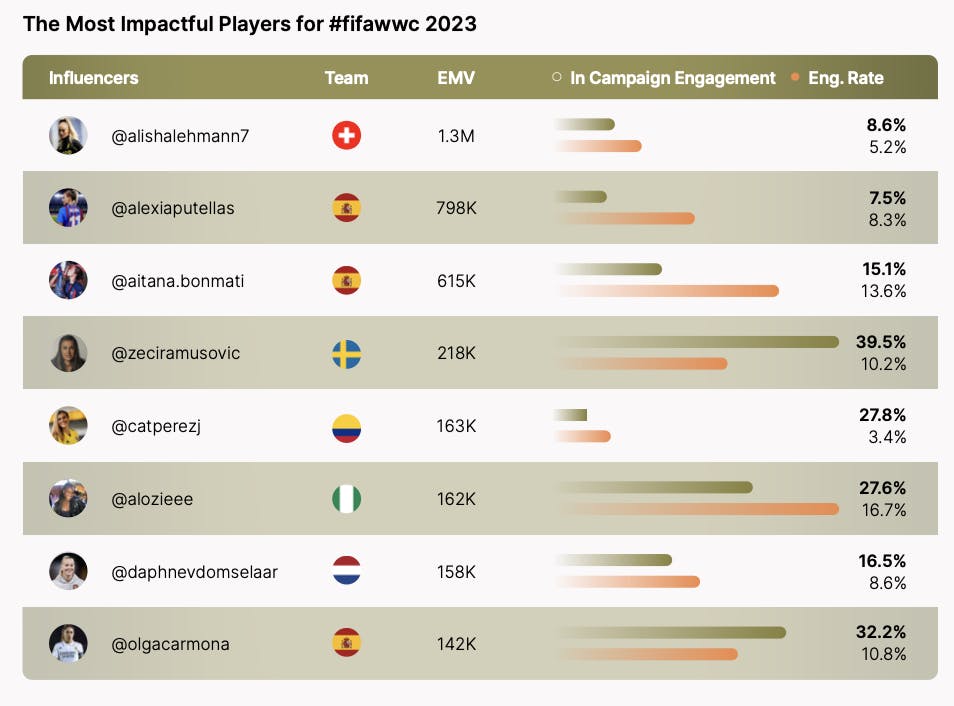
Women Rising Interview: @ellatoone
Profile Information
Lioness Ella Toone was one of the most dominant players in the Women’s World Cup. The attacking midfielder has inspired young women all over the world, not only with her football but also her presence on social media and her love for fashion and beauty.
We talk exclusively with Ella about the rise of partnership opportunities within women’s sports.
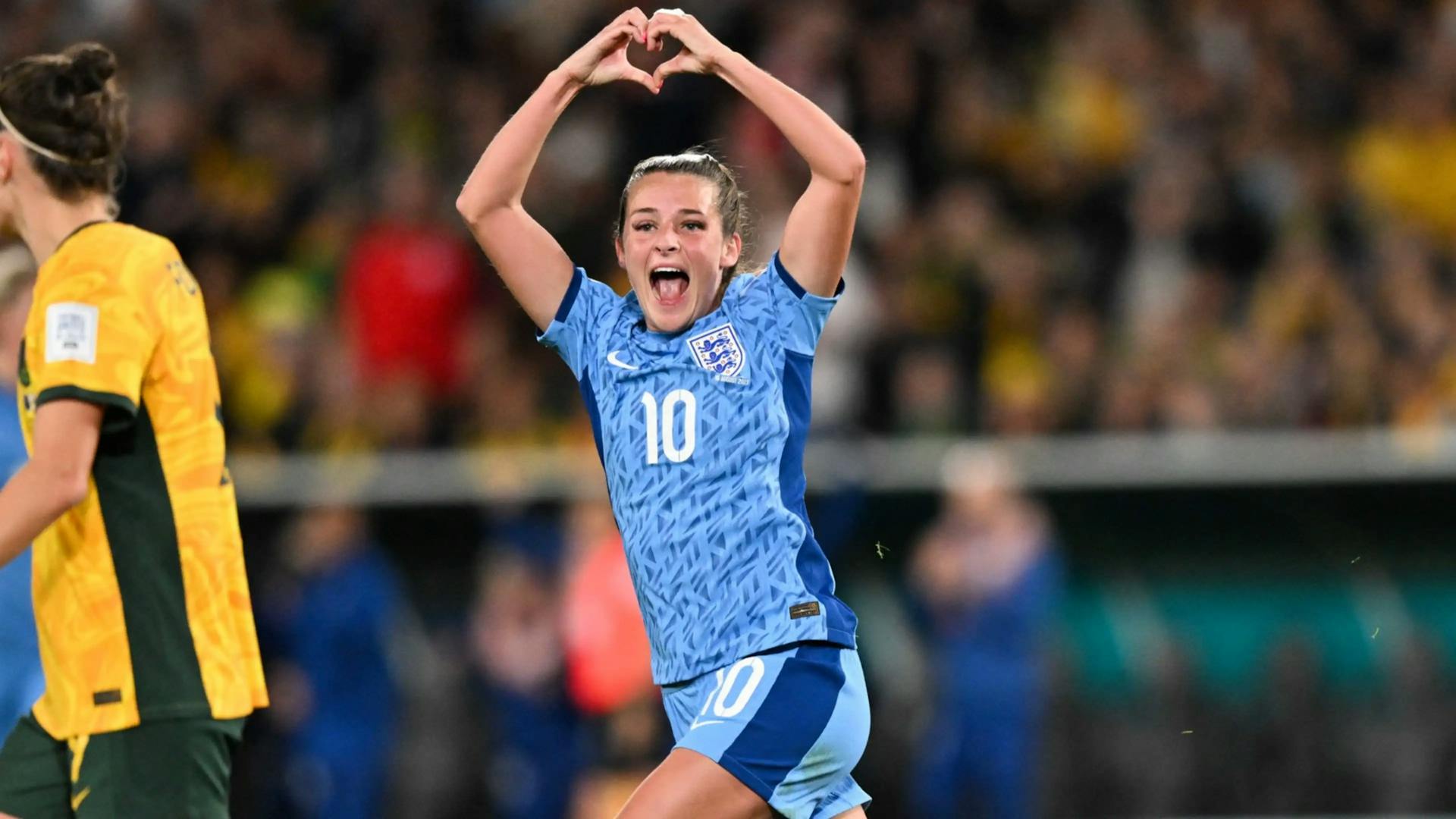
Q: How are you utilizing social media to spread awareness of the Women’s game?
A: For me, it was the realization of my having an impact on children. I think the Euros changed; my team and I were getting inundated with requests and videos, so I decided to create my own YouTube channel to give back to my fans. Show them a bit behind the scenes and what I get up to. I don’t like big cameras, so it started with my social media guy filming me on his phone while I was traveling up and down the country. I wasn’t sure of its impact at first, but it’s grown rather quickly, and even young girls were coming up to me in Australia saying they couldn’t wait for the next episode, which was so good
to hear. How could they be watching my content from the other side of the world? It’s mad!
Q: Are you getting more brand opportunities since the Women’s World Cup/ Euros?
A: After the Euros, yes, there were some incredible opportunities for the team and me. I haven’t seen that type of attention after the World Cup. Maybe because we were beaten in the final (laughs), or it was in Australia, or people's focus has shifted elsewhere, but I do feel more brands need to create opportunities for the women’s game.
Q: What are the long-term pathway opportunities for female athletes?
A: Opportunities need to keep on improving for female athletes. Every little girl should have the chance to play sports, and that’s very important. Things are improving, and facilities are continuing to open throughout the UK, so there are good signs, but there needs to be more. I’m very fortunate to have a facility built from the foot-
ball foundation named after me in my community, and hopefully, that can help encourage more female players to get involved in football.
Q: There’s been a massive uptick in female audiences watching women’s sports. Do you think this will have a knock-on effect on other sports?
A: I’m hoping so; winning the Euros has had a massive impact on more participation, and long may that continue across all sports. If we can inspire children to participate in any sports, it would be an amazing feeling to feel that we’ve made a difference.
Q: What type of brands do female athletes gravitate towards and why?
A: All brands; my teammates love designer brands who don’t (laughs). Fashion and beauty are so important to me. If I don’t get my nails and eyelashes done before a game, they’re just not the same. We’re girls at the end of the day and would like to make an effort. Look good, play good, as they say!
Q: What would you say is the current level of involvement of luxury brands in women’s football?
A: Very little, to be honest. A few brands have flirted with it, but I don’t think any luxury brand has come and owned the women’s game. There are so many characters and personalities in the game, and with attendance figures and viewership going through the roof, it’s a perfect time to get involved.
Scoring with Beauty and Wellness
An Under-Explored Market
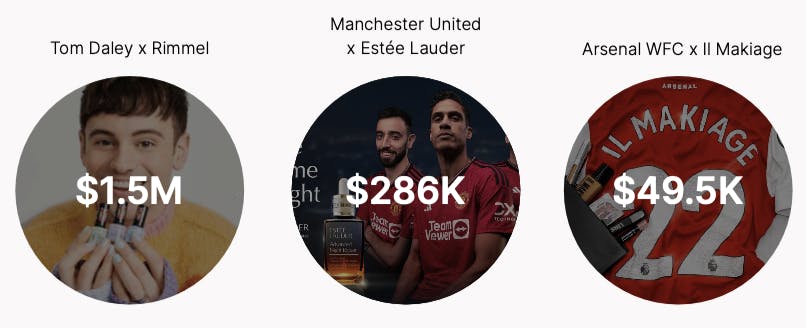
The synergies between sports, beauty, and wellness appear naturally aligned. Yet, the market remains underexplored in brand partnerships, constituting a mere 0.5% of collaborations. As Lefty's data highlights, such alliances predominantly gravitate towards mass-market, performance-centric brands tailored to a male demographic.
Karla Otto and Lefty's experts forecast a change in beauty's escalating influence in sports, driven by the burgeoning impact of women's sports and the evolving societal shifts surrounding gender identity.
Redefining Appeal
Beauty products that lean into the performance narrative are an obvious fit when it comes to sporting talent. Think active, cosmeceutical skincare, SPF, etc. But I think we will start seeing much more makeup, hair care, and fragrance talent partnerships that aren’t relying solely on performance messaging. Sports stars can love beauty on and off the field.
Manchester Utd’s Skincare Moment
Boyd’s sentiments are affirmed by several recent brand partnerships across male and female teams: ‘In July 2023, Manchester United Men’s team welcomed Estée Lauder as their Skincare partner, while New York’s Il Makiage partnered with Arsenal Women’s team as their official beauty sponsor. Pioneering inclusivity, British Diver Tom Daley became Rimmel London’s first male ambassador, yielding substantial EMV in a partnership that developed from placements to a product collaboration.
Power and Beauty
“Beauty products that lean into the performance narrative are an obvious fit when it comes to sporting talent. Think active, cosmeceutical skincare, SPF, etc. But I think we are going to start seeing much more makeup, hair care, and fragrance talent partnerships that aren’t relying solely on performance messaging. Sports stars can love beauty on and off the field.”
Scoring with Beauty and Wellness Case Study: @alishalehmann7
As more women athletes cut through the noise, brands should look for partnerships that resonate with their image. Alisha Lehmann's profile highlights her love for beauty, yet only the perfume brand has begun working with Women's football's most visible athlete.
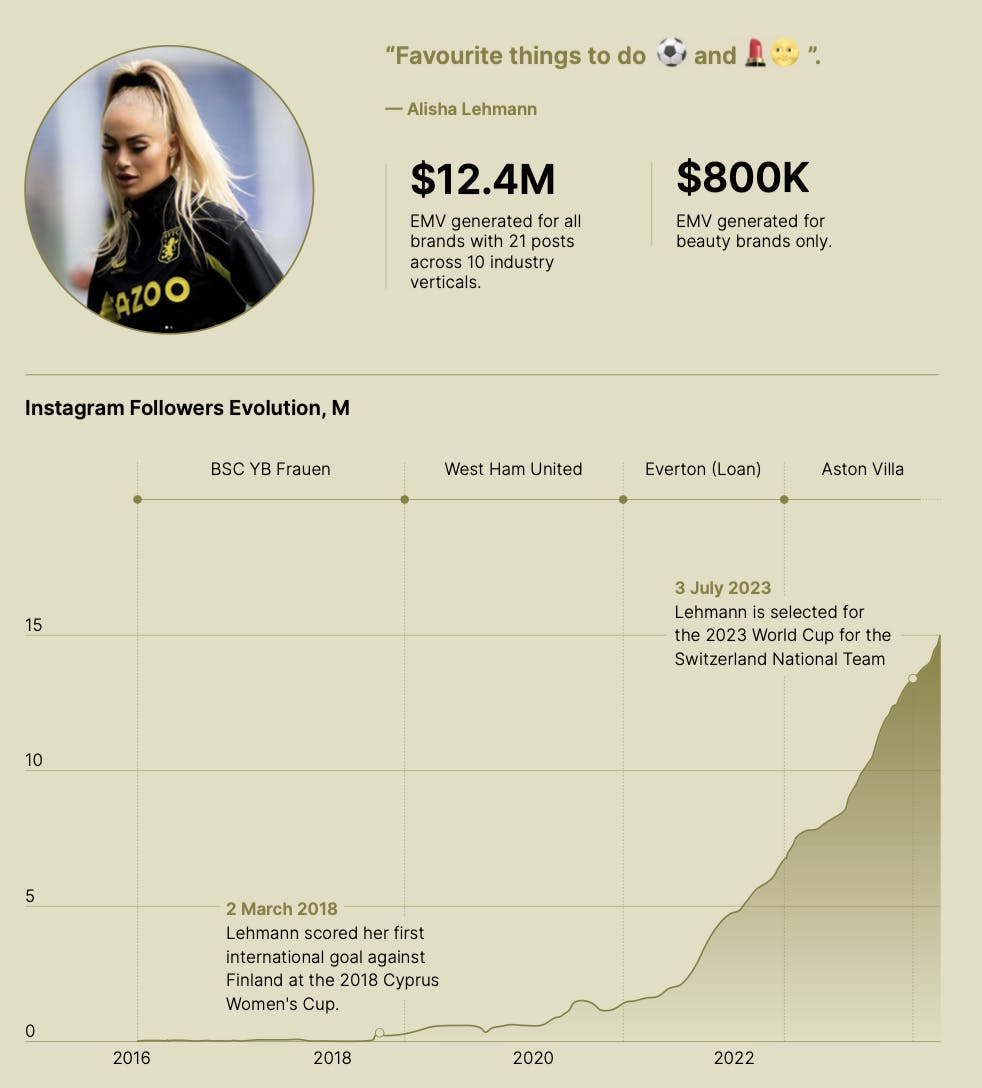
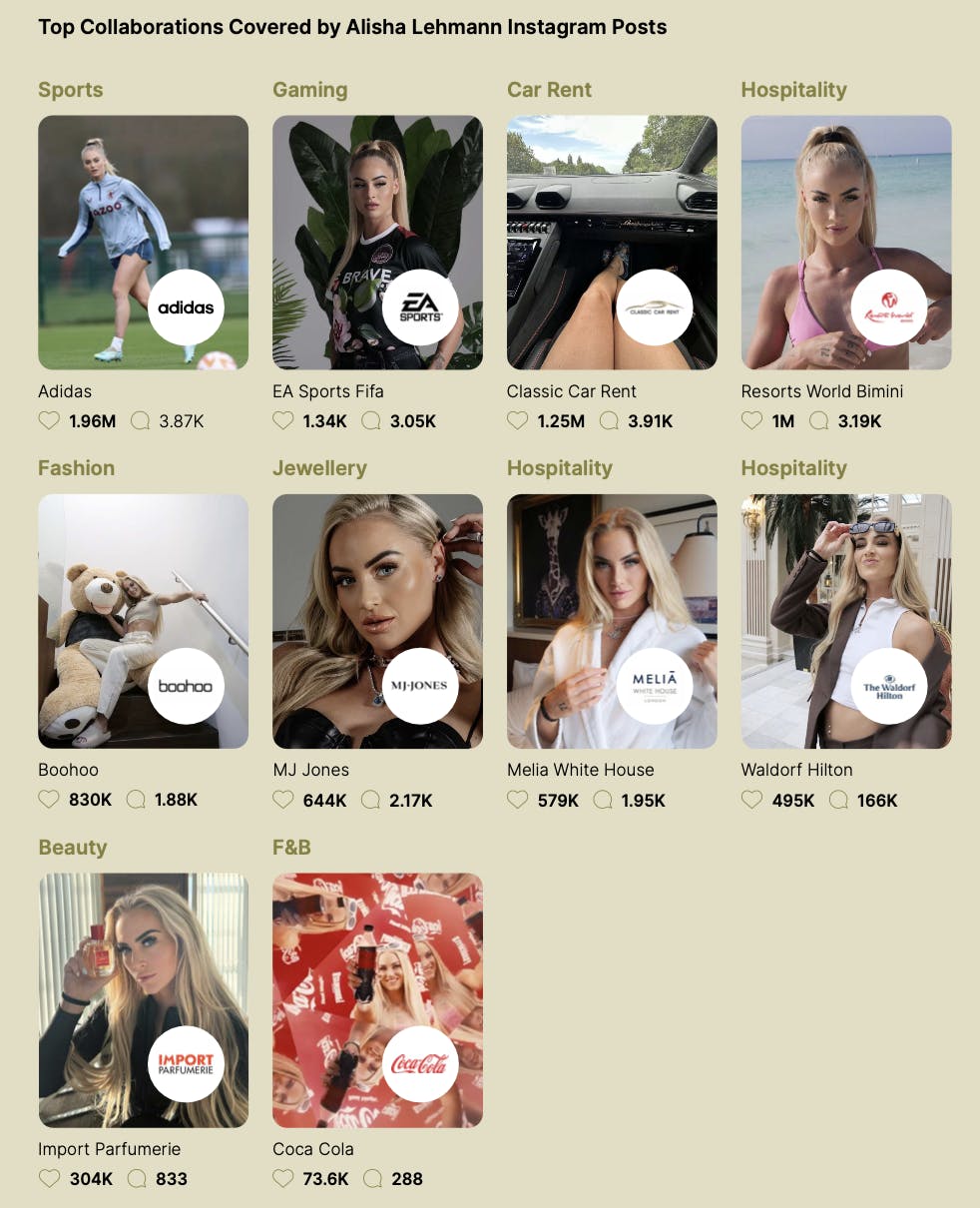
Rooting for the Underdog
New Faces & Niche Sports
Whereas brand deals used to be reserved for the highest-profile athletes, the rise in views of niche sports and a plethora of young athletes are enabling a new wave of partnerships, creating a perfect entry point for product placement for brands with budget limitations. The Olympic and Paralympic 2024 Games, in particular, will be primed for opportunities, having announced several new categories that are set to welcome a new wave of sports stars. Breakdancing, a new weight in women’s boxing, kitesurfing, and many more join Tokyo’s introductory o- offers of surfing, climbing, and skateboarding.
Reaching New Markets
Working with a global roster of sports stars is a great way to enter a new market and reach new audiences. Jo Malone London tapped rising NBA star Jarace Walker to promote their Men’s Fragrance in the US market, utilizing the sport's powerful cultural cache and high-reach stateside. Meanwhile, ROXY recently signed India’s first professional Indian surfer via Ishita Malaviya.
Community, Culture, and Values
When it comes to working with new talent, it’s not all about mass followings. Choosing a profile that is aligned with brand values and has an audience that is the correct demographic and highly engaged with the profile's content can create a more authentic message when it comes to partnerships. Karla Otto and Lefty lead in identifying emerging talent for partnerships and uncovering the key metrics that showcase the validity of the talent.
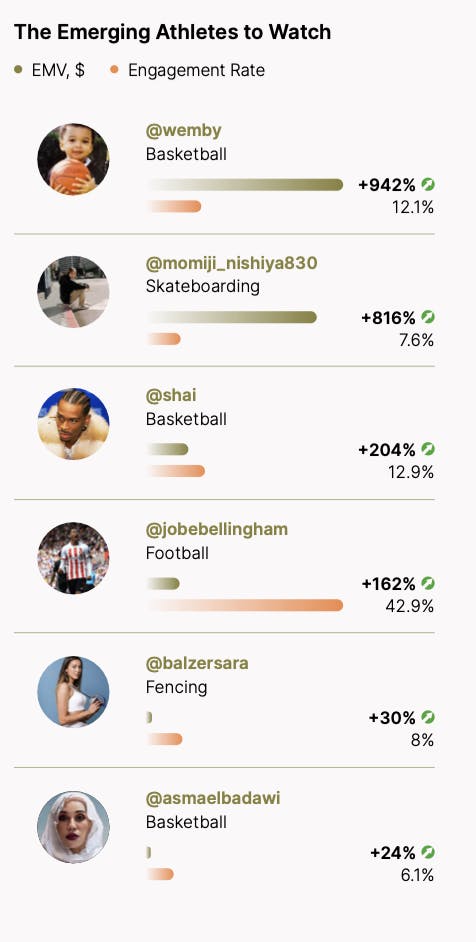
Action Points
- Selecting the Right Talent & Building Relationships
Choosing the perfect athlete for your brand is crucial. Their authenticity, closely tied to their performance, should align with your brand values and resonate with your target audience. Lefty's tools help you assess an athlete's profile metrics to ensure a seamless fit while tracking the impact of your influencer campaigns. Meanwhile, Karla Otto’s over 40 years of expertise in forming globally recognized partnerships and collaborations allows us to steer brands into the center of culture. - Capitalizing on Emerging Markets The sports industry’s growth, evolving athlete profiles, and shifting cultural dynamics offer exciting opportunities beyond traditional sports partnerships. Customize Lefty’s competitive report to reveal how your competitors perform, who they partner with, and more to stay ahead by identifying new opportunities or strengthening your brand’s position in the market.
- Understanding Cultural Influence
Prioritizing culture and community in your brand strategy is pivotal for global recognition. Sports now have media value and cultural significance, fuelled by docu-series and strategic brand collaborations. Engage with Karla Otto’s VIP team to explore diverse ways of partnering with talent while measuring the impact using Lefty’s unparalleled influencer tools. - Embracing Fresh Talent
Working with emerging athletes and trending sports can provide an authentic connection with a new audience at a more cost-effective rate in a saturated sports landscape. The upcoming Olympics and Paralympic Games present a prime opportunity to engage with a wave of new athletic talent. Collaborate with Lefty and Karla Otto to discover and evaluate the impact of these rising stars on your audience. - Innovative Activation Strategies Strategic presence at key events is essential for success. The upcoming Paris Olympic Games offer an abundance of opportunities for pop-ups, events, and influencer partnerships. Consider partnering with POPs (partners of players) for an authentic influencer marketing approach during your brand’s significant moments. Connect with Karla Otto’s Insights and Digital team to craft unforgettable brand experiences at these pivotal events.
Data Appendix
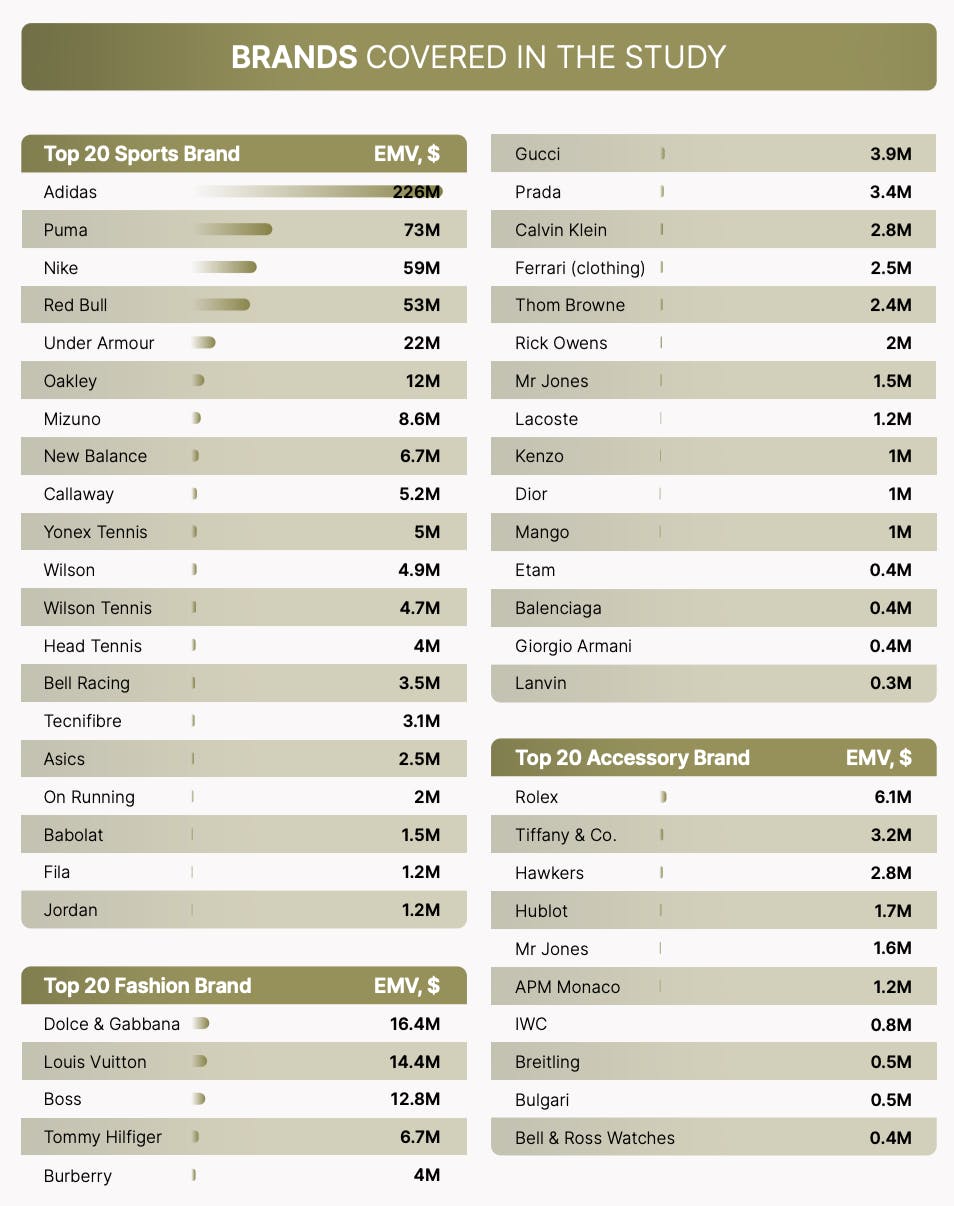
Sports Brands by Numbers
Sports apparel giants Adidas, Nike, and Puma dominate the industry. Adidas stands out as the most prominent brand. In contrast, all other sports apparel brands fall behind, collaborating with fewer than 100 athletes. This reveals a substantial opportunity for growth and expansion within the industry.
